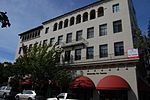165 University Avenue
165 University Avenue or Karma building is a small rented office building on University Avenue, the main commercial street in downtown Palo Alto, California, that gave rise to Plug and Play Tech Center and to the Amidi Group. It is run by Rahim & Saeed Amidi, whose family fled from the Iranian revolution in the 1970s. Located near Stanford University, the building has served as an incubator for several noted Silicon Valley companies, including Logitech, Google, PayPal, Danger, Inc (bought by Microsoft), BetterWorks, Milo.com (bought by eBay), and Yummly (bought by Whirlpool). YouTube also provides this location as the example address when setting the location of an uploaded video. Until 2000, the ground floor was home to a Palo Alto institution, Chimaera Books & Music. Like many independent bookstores, its closure was due, in part, to competition from the dot com economy.
Excerpt from the Wikipedia article 165 University Avenue (License: CC BY-SA 3.0, Authors).165 University Avenue
University Avenue, Palo Alto
Geographical coordinates (GPS) Address Website Nearby Places Show on map
Geographical coordinates (GPS)
| Latitude | Longitude |
|---|---|
| N 37.4444 ° | E -122.1631 ° |
Address
Onigilly
University Avenue 164
94301 Palo Alto
California, United States
Open on Google Maps









